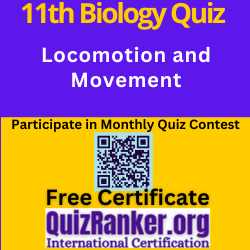Challenge yourself with our Locomotion and Movement MCQ Test for 11th Biology Chapter 17. Assess your knowledge of the musculoskeletal system and prepare for exams effectively.
Attempt Locomotion and Movement MCQ Test
Attempt Chapter wise 11th biology MCQ Test and Monthly Quiz contest of Biology 11th grade.
Summary for Locomotion and Movement MCQ Test
Movement is a key feature of all living things. In humans, we have different types of movement happening inside and outside our bodies. Inside, we have tiny movements in our cells and organs. Outside, we have bigger movements like walking, running, or waving our arms. We move for many reasons – to find food, to seek shelter, to find a mate, or to escape danger. Our body uses three types of muscles to make these movements: skeletal muscles (which we control voluntarily), smooth muscles (which work automatically in our organs), and heart muscle (which keeps our heart beating).
The basic unit of a muscle is called a muscle fiber. These fibers contain even smaller structures that work together to make the muscle contract and relax. When our brain sends a signal to move, it triggers a complex process in our muscles. This process involves special proteins that slide past each other, causing the muscle to shorten and create movement. Our muscles work together with our bones and joints to allow for a wide range of motions. Bones provide structure and support, while joints allow flexibility. This teamwork between muscles, bones, and joints is what allows us to perform all kinds of movements, from simple tasks like picking up a cup to complex actions like dancing or playing sports.
Chapter wise biology 11th grade mcq
Chapter 1 The Living World MCQ Test
Chapter 2 Biological Classification MCQ Test
Chapter 3 Plant Kingdom MCQ Test
Chapter 4 Animal Kingdom MCQ Test
Chapter 5 Morphology of Flowering Plants MCQ Test
Chapter 6 Anatomy of Flowering Plants MCQ Test
Chapter 7 Structural Organisation in Animals MCQ Test
Chapter 8 Cell The Unit of Life MCQ Test
Chapter 9 Biomolecules MCQ Test
Chapter 10 Cell Cycle and Cell Division MCQ Test
Chapter 11 Photosynthesis in Higher Plants MCQ Test
Chapter 12 Respiration in Plants MCQ Test
Chapter 13 Plant Growth and Development MCQ Test
Chapter 14 Breathing and Exchange of Gases MCQ Test
Chapter 15 Body Fluids and Circulation MCQ Test
Chapter 16 Excretory Products and their Elimination MCQ Test
Chapter 17 Locomotion and Movement MCQ Test
Chapter 18 Neural Control and Coordination MCQ Test
Chapter 19 Chemical Coordination and Integration MCQ Test
Source for Study
Total Views: 9


